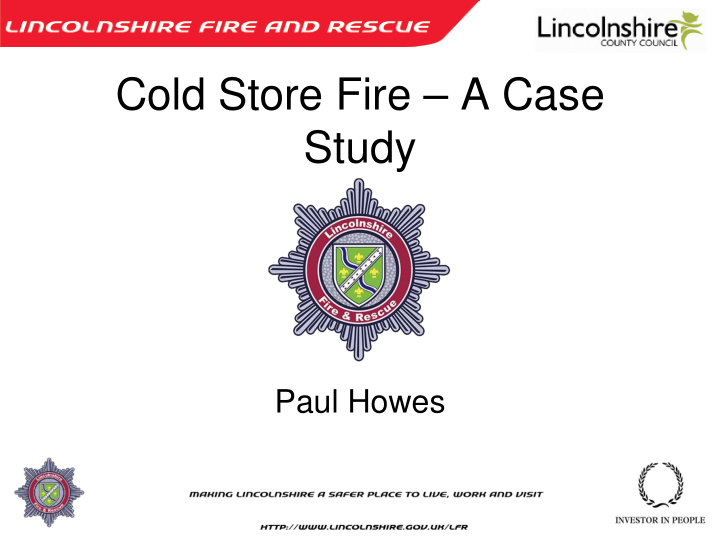



Cold Store Fire – A Case Study Paul Howes 1
Issues surrounding a fire 2
Initial Attendance • All persons accounted for * • Safe location – correct assembly point • Location and nature of the fire • Premises risks • Grab packs • Responsible person (identification) • Technical knowledge • Hazards – acetylene, asbestos, ammonia, processes (plant, machinery) etc. • Fire fighting systems operated or available • Services – gas, electrics, solar panels etc. – isolating points • Resources, water supplies, tactics 3
Water Supplies Pre-planning to identify supplies - •Hydrants – on and off site •On site static open water lagoons •Water treatment plant •Local open water 4
Fire Spread Composite Insulated Panels • Numerous types with differing characteristics • Mineral Fibre – was glass fibre now a stone mineral wool • Polyurethane Foam (PUR) – pre 2000 installs • Polyisocyanurate Foam (PIR) • Polystyrene • Phenolic Foam (PF) • Type of panels in use should be identified as part of the pre-planning stage - PUR, PIR & PF visually similar Other factors: • Operational tactics will be defensive except for known savable lives • Wind direction • Building materials • Contents • Terrain 5
Fire Spread Composite Insulated Panels – Hazards! • Rapid fire spread within the panel / flashover • Rapid structural collapse • Difficulty fighting fires within the concealed core • Melting core creates a burning liquid fire (also assists fire spread). Molten droplets a significant risk to firefighters • Delamination exposes the core to direct fire and increases fire spread • Liberation of large volumes of dense toxic smoke • Exposed cores can absorb water leading to early collapse 6
Smoke Plume Smoke contents: • Nitrous oxides • Hydrogen sulphide • Carbon Monoxide • Hydrogen cyanide • Ammonia • Phosgene • Asbestos What goes up must come down! 7
Smoke Plume Considerations: • Wind direction / speed • Fallout zone • Evacuation • Contamination 8
Water Run-off considerations • Pumping capacity – 2250 lpm - standard bath holds 227 litres • Sprays rather than jets • Controlled burn – Pollution Prevention Guidelines (PPG28) • Recycling of water Containment: • Bunds • Storage lagoons • Interceptors • Pre-identified sacrificial water courses • Aquifer polution 9
Legislation • The Environmental Damage (Prevention & Remediation ) Regulations 2009 and the Environmental Liability Directive 2004/35/EC applies the “Polluter pays” principle • Fire Services Act 2004 Part 6 Article 44 provides power to reasonably do anything believed necessary for the purpose of extinguishing a fire or protecting life or property • Except to save lives or prevent a fire spreading the Fire and Rescue Service will not overrule the Environment Agency with regard to ceasing firefighting operations! 10
Pre-Planning 4 ways to reduce the risk: • Prevention: Give the highest priority to preventing the fire in the first place, for example by segregating or controlling sources of ignition • Detection: If a fire does start it should be detected and tackled as quickly as possible. Automatic detection and protection systems such as sprinklers can significantly reduce the size of a fire in the early stages • Containment: Consider the installation of facilities for the containment of fire water. Guidance on this can be provided by your local fire service and also the Environment Agency • Mitigation: Plan in advance with your fire and rescue service suitable fire- fighting strategies such as: • Reducing the amount of water by using sprays rather than jets • Recycling fire water where this is not hazardous • A controlled burn where it is safe to do so. Where any action is required to prevent fire spread (cooling of tanks etc.) care should be taken to ensure that the water does not become a pollutant or the cooling process does not increase air pollution Pre-planning and prevention are always cheaper than reaction ! 11
Factors to consider: • The Fire Service will take a controlled risk to protect savable property. They will not risk their lives to protect property which cannot be saved (4 firefighters lost their lives at the Atherstone on Stour vegetable packing plant in 2007) • The fire does not just affect the site. Persons within the fallout area (downwind) are classed as relevant persons under the Regulatory Reform (Fire Safety) Order 2005. You have a duty to consider them • Third party claims–illness, injury, damages = COMPENSATION • Pre-planning and prevention are always cheaper than reaction. Work with your local service and develop and exercise emergency plans • Removal of staff – may not have access to the site to collect belongings • Longer term continuity planning / post incident recovery. 12
Any Questions 13
Recommend
More recommend